Opinion & Analysis
Getting to know Payne Stewart
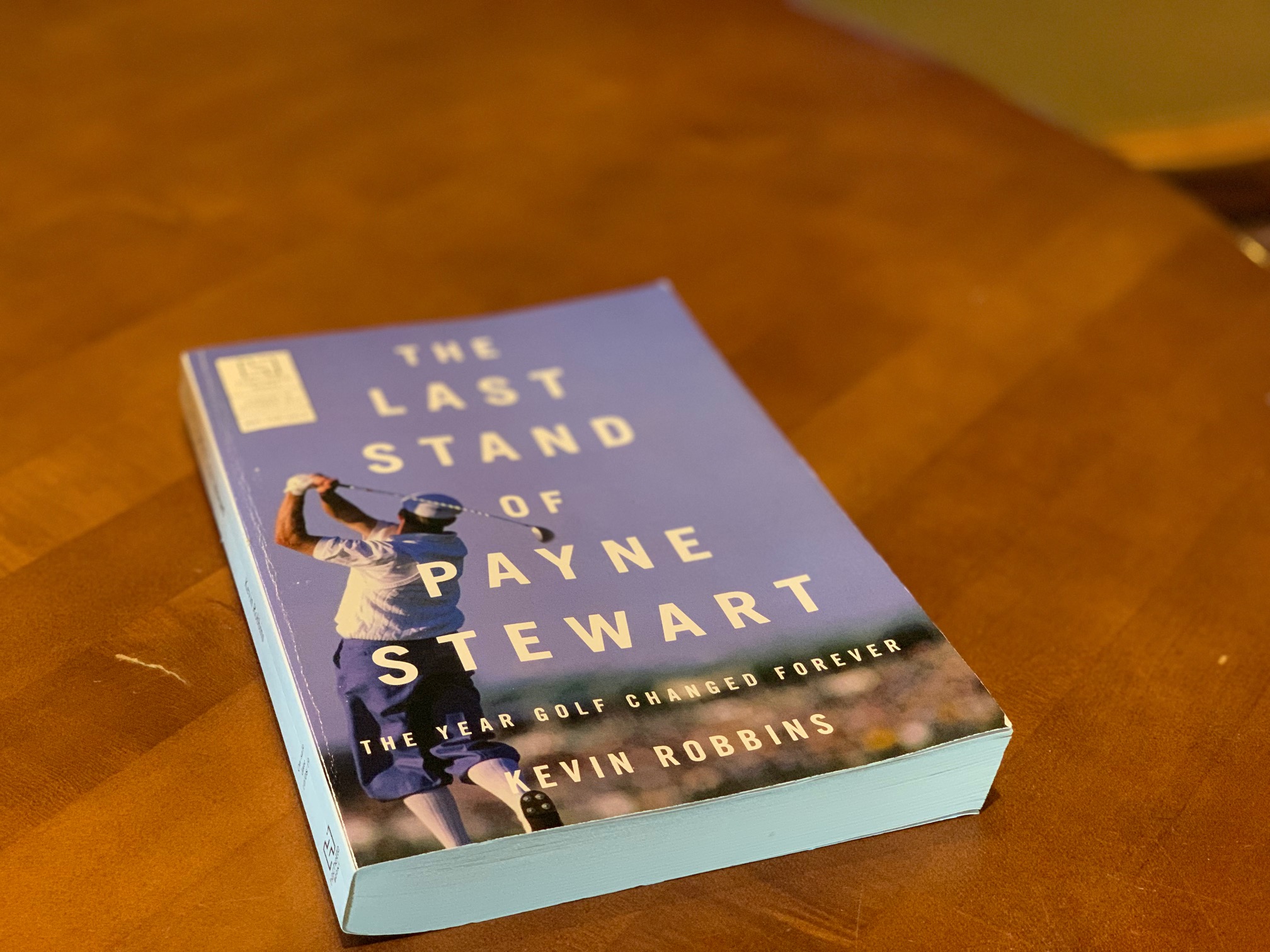
Ever since that final putt fell in Pinehurst in 1999, Payne Stewart’s memory has enjoyed mythical qualities. A man of complex charm, but many of us who grew up without him recognize only his Knickerbocker pants, his flat cap, and his W.W.J.D. covered wrist wrapped around that United States Open trophy.
I had a wonderful opportunity to play a round of golf with two men that know a lot about Payne. One through friendship and the other through journalistic research.
Lamar Haynes was Payne Stewart’s close friend and teammate on the SMU golf team. He’s full of stories about Payne from the good old days. Kevin Robbins is an author who just finished a new book on Stewart’s final year of life, set to release to the public for purchase this October. He works as a professor of journalism at the University of Texas but has also enjoyed an impressive career as a reporter and golf writer for over 20 years.
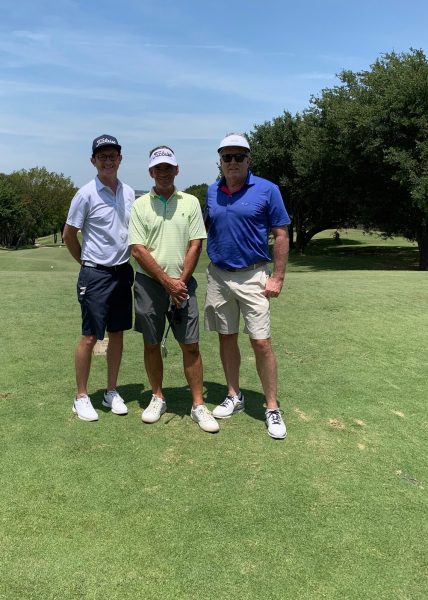
We met at Mira Vista Country Club in Fort Worth, Texas, to talk about Payne. Robbins is a solid golfer who spends time working on his game, which tells me a lot about his personality. He is one of us. As for Haynes, the guy hasn’t lost much since those SMU golf team days. He can still swing it. Fantastic iron player. And both men are wonderful conversationalists. They offered a unique perspective on Stewart—the golfer I grew up idolizing but never really knew. There’s a good chance you don’t really know him, either. At least not the whole story.
“Most golf fans now know the story of his ’99 U.S. Open win,” Robbins said. “What they don’t know is where he came from.”
Robbins’ book, The Last Stand of Payne Stewart: The Year Golf Changed Forever, chronicles Payne’s last year on earth with dramatic detail, covering his triumph at Pinehurst and the Ryder Cup at Brookline. And, of course, it tells the story of that tragic plane crash that took our champion from us. What the book doesn’t do is hide any of the blemishes about Payne’s life that have either been forgotten or pushed aside by brighter moments and memories.
“I thought that the other Payne Stewart books, while they have a place, they didn’t tell the whole story,” Robbins said.
The whole story, from what I read, was Payne being brash. A poor winner and sometimes a poor sport when he lost. He often said things he shouldn’t have said and then made those mistakes again and again.
“He had no filter,” remembered Haynes. “Several close friends on tour had a hard time with him when he won his first Open. He didn’t take into account any of the consequences his words could create. He had a huge heart. Huge heart. But at times there was just no filter. But he grew a great deal over the last 2 or three years.”
It’s most certainly is a book about a change. A change in a man that was better late than never. But also a change in golf that began at the turn of the century and hasn’t really slowed down since.
“The 20 years since his death, to see the way golf has moved, what the tour looks like now,” Robins said. “There was an evolution that was taking place in 1999 and we didn’t know how it would manifest itself. But now we do. So when you see Brooks Koepka hit a 3-wood in the US Open 370 yards, well that all really had its beginnings in 1998 and 1999. The Pro-V1 ball was being tested in 1999 and being rolled out in 2000. Fitness and equipment, sports psychology, nutrition. All of those things that a guy like Payne Stewart really didn’t have to pay attention to.”
But that change that occurred in Payne, culminating in his final year of life, is something worth learning. It’s a lesson for all of us. A guy on top of the world with still so much to fix. And he was fixing it, little by little.
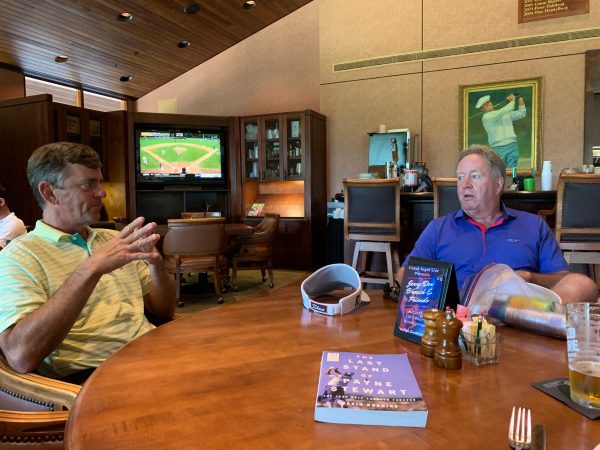
“He was authentic,” Haynes said. “And he learned a lot later in life from his children. With their Bible studies. You saw a change in him. Very much. He had a peace with himself but he still would revert to his DNA. The fun-loving Payne. Raising children and being a father helped him tremendously.”
Payne was passionate about so many things in life but his children became a primary focus. According to Haynes, he would be so loud at his daughter’s volleyball games…yelling intensely at the referees…that they gave him an option: Either he wouldn’t be allowed to watch the games anymore or he needed to become a line judge and help out with the games. So, Payne Stewart became a volleyball line judge.
Lamar brought the head of an old Ram 7-iron along with him to show me. Damaged and bent from the crash, the club was with Payne on his final flight. He had it with him to show his guys at Mizuno as a model for a new set of irons. That Ram 7-iron belonged to Haynes and Payne had always adored the way it looked at address.
“Payne also used my old Mizunos the last year of his life,” Haynes said. I had received the MS-4s 10 years earlier from Payne in 1989. They were like playing with a shaft on a knife. The sweet spot was so tiny on the MS-4. They made the MP29 and 14s look like game improvement irons. Payne used those. Then Harry Taylor at Mizuno designed him an iron, which later became the MP33. The 29 and 14s were very sharp and flat-soled. Well, Payne loved this old Ram iron set that I had.. He asked for my Ram 7-iron for Harry Taylor to model his new set. He liked the way it went through the turf. He had it with him on the plane. This is the club that started the MP33.”


It was Lamar Haynes, the man who seems to know just about everyone in the golf community, that set Robbins on this writing journey. Robbins had written one book previously: The story of the life of legendary golf coach Harvey Penick. But this book came a bit easier for Robbins, partly due to his experience, partly due to the subject matter, and partly because of Lamar.
“There’s a story here,” Robbins said. “With any book, you hope to encounter surprises along the way, big and little. And I did. I got great cooperation a long the way. Anybody I wanted to talk to, talked to me thanks to this guy Lamar Haynes.”
“Lamar said the first guy you need to talk to is Peter Jacobsen,” Robins said. “And I said ‘great can you put me in touch with him’ which became a common question to Lamar throughout the process.” Robbins chuckled. “Literally 2 minutes later my phone rings. ‘Kevin, this is Peter Jacobsen here.'”
“Peter told me the story about the ’89 PGA championship in our first conversation. So literally in the first 10 minutes of my reporting effort, I had the first set piece of the book. I had something. Lamar made a lot happen.”
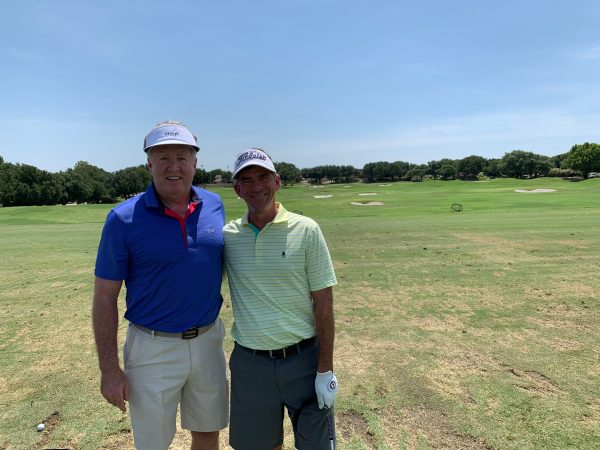
Lamar Haynes and Kevin Robbins
The book is not a biography, though it certainly has biographical elements to it. It is simply the story of Payne’s final year, with a look back at Payne’s not so simple career mixed in. The author’s real talent lives in the research and honesty. The story reads like you’re back in 1999 again, with quotes pulled from media articles or press conferences. Anecdotes are sprinkled here and there from all of Payne’s contemporaries. The storytelling is seamless and captivating.
“I was pleasantly surprised how much Colin Montgomerie remembered about the concession at the 1999 Ryder Cup,” Robbins said. “Colin can be a tough interview. He is generally mistrustful of the media. His agent gave me 15 minutes during the Pro-Am in Houston. This was in the spring of 2018. I met Colin on the 17th hole and he had started his round on 10. Just organically the conversation carried us to the fifth green. Just because he kept remembering things. He kept talking, you know. It was incredible. Tom Lehman was the same way. He said “I’ll give you 20 minutes” and it ended up being an hour and a half at Starbucks.”
The research took Robbins to Massachusetts, Florida, and Missouri—and of course, to Pinehurst. He met with Mike Hicks, Payne’s former caddie, there to discuss that final round. The two ended up out on Pinehurst No. 2, walking the last three holes and reliving the victory. It gives life to the story and fills it with detail.
“Part of what I hoped for this book is that it would be more than just a sports story,” Robbins said. “More than just a golf story. The more I started thinking about where Payne began and where he ended, it seemed to me…and I’m not going to call it a redemption story although I bet some people do. People when they are younger, they have regrets and they make mistakes. They do things they wish they could take back but they can’t. So, what can they do? Well, they can improve. They can get better. That’s what Payne was doing with his life. He was improving himself. It was too late to change what he had done already. So what could he do with the future? He could be different.”
“It was accurate,” Haynes said. “I had a tear when I finished it. I texted Kevin right afterward. I told him I couldn’t call him because I’m choked up so I texted him.”
So here’s two men who knew Payne Stewart, albeit in very different ways. They knew he was flawed in life but he got better. Was Payne Stewart that hero at Pinehurst, grabbing Phil Mickelson’s face and telling him the important thing is he’s going to be a father? Yes. But he was so much more than that. He was so much more than I knew before I read this book. Most importantly, Payne Stewart was always improving. A lesson for all of us, indeed.
If you want to hear more about my experience, tweet at me here @FWTXGolfer or message me on Instagram here! I look forward to hearing from you!

- LIKE133
- LEGIT32
- WOW24
- LOL2
- IDHT1
- FLOP1
- OB2
- SHANK0
19th Hole
Vincenzi’s 2024 Texas Children’s Houston Open betting preview

As the Florida swing comes to an end, the PGA Tour makes its way to Houston to play the Texas Children’s Houston Open at Memorial Park Golf Course.
This will be the fourth year that Memorial Park Golf Course will serve as the tournament host. The event did not take place in 2023, but the course hosted the event in 2020, 2021 and 2022.
Memorial Park is a par-70 layout measuring 7,432 yards and features Bermudagrass greens. Historically, the main defense for the course has been thick rough along the fairways and tightly mown runoff areas around the greens. Memorial Park has a unique setup that features three Par 5’s and five Par 3’s.
The field will consist of 132 players, with the top 65 and ties making the cut. There are some big names making the trip to Houston, including Scottie Scheffler, Wyndham Clark, Tony Finau, Will Zalatoris and Sahith Theegala.
Past Winners at Memorial Park
- 2022: Tony Finau (-16)
- 2021: Jason Kokrak (-10)
- 2020: Carlos Ortiz (-13)
In this article and going forward, I’ll be using the Rabbit Hole by Betsperts Golf data engine to develop my custom model. If you want to build your own model or check out all of the detailed stats, you can sign up using promo code: MATTVIN for 25% off any subscription package (yearly is best value).
Key Stats For Memorial Park
Let’s take a look at several metrics for Memorial Park to determine which golfers boast top marks in each category over their last 24 rounds:
Strokes Gained: Approach
Memorial Park is a pretty tough golf course. Golfers are penalized for missing greens and face some difficult up and downs to save par. Approach will be key.
Total Strokes Gained: Approach per round in past 24 rounds:
- Tom Hoge (+1.30)
- Scottie Scheffler (+1.26)
- Keith Mitchell (+0.97)
- Tony Finau (+0.92)
- Jake Knapp (+0.84)
Strokes Gained: Off the Tee
Memorial Park is a long golf course with rough that can be penal. Therefore, a combination of distance and accuracy is the best metric.
Total Strokes Gained: Off the Tee per round in past 24 rounds:
- Scottie Scheffler (+0.94)
- Kevin Dougherty (+0.93)
- Cameron Champ (+0.86)
- Rafael Campos (+0.84)
- Si Woo Kim (+0.70)
Strokes Gained Putting: Bermudagrass + Fast
The Bermudagrass greens played fairly fast the past few years in Houston. Jason Kokrak gained 8.7 strokes putting on his way to victory in 2021 and Tony Finau gained in 7.8 in 2022.
Total Strokes Gained Putting (Bermudagrass) per round past 24 rounds (min. 8 rounds):
- Adam Svensson (+1.27)
- Harry Hall (+1.01)
- Martin Trainer (+0.94)
- Taylor Montgomery (+0.88)
- S.H. Kim (+0.86)
Strokes Gained: Around the Green
With firm and undulating putting surfaces, holding the green on approach shots may prove to be a challenge. Memorial Park has many tightly mowed runoff areas, so golfers will have challenging up-and-down’s around the greens. Carlos Ortiz gained 5.7 strokes around the green on the way to victory in 2020.
Total Strokes Gained: Around the Green per round in past 24 rounds:
- Mackenzie Hughes (+0.76)
- S.H. Kim (+0.68)
- Scottie Scheffler (+0.64)
- Jorge Campillo (+0.62)
- Jason Day (+0.60)
Strokes Gained: Long and Difficult
Memorial Park is a long and difficult golf course. This statistic will incorporate players who’ve had success on these types of tracks in the past.
Total Strokes Gained: Long and Difficult in past 24 rounds:
- Scottie Scheffler (+2.45)
- Ben Griffin (+1.75)
- Will Zalatoris (+1.73)
- Ben Taylor (+1.53)
- Tony Finau (+1.42)
Course History
Here are the players who have performed the most consistently at Memorial Park.
Strokes Gained Total at Memorial Park past 12 rounds:
- Tyson Alexander (+3.65)
- Ben Taylor (+3.40)
- Tony Finau (+2.37)
- Joel Dahmen (+2.25)
- Patton Kizzire (+2.16)
Statistical Model
Below, I’ve reported overall model rankings using a combination of the five key statistical categories previously discussed.
These rankings are comprised of SG: App (24%) SG: OTT (24%); SG: Putting Bermudagrass/Fast (13%); SG: Long and Difficult (13%); SG: ARG (13%) and Course History (13%)
- Scottie Scheffler
- Wyndham Clark
- Tony Finau
- Joel Dahmen
- Stephan Jaeger
- Aaron Rai
- Sahith Theegala
- Keith Mitchell
- Jhonnatan Vegas
- Jason Day
- Kurt Kitayama
- Alex Noren
- Will Zalatoris
- Si Woo Kim
- Adam Long
2024 Texas Children’s Houston Open Picks
Will Zalatoris +2000 (Caesars)
Scottie Scheffler will undoubtedly be difficult to beat this week, so I’m starting my card with someone who I believe has the talent to beat him if he doesn’t have his best stuff.
Will Zalatoris missed the cut at the PLAYERS, but still managed to gain strokes on approach while doing so. In an unpredictable event with extreme variance, I don’t believe it would be wise to discount Zalatoris based on that performance. Prior to The PLAYERS, the 27-year-old finished T13, T2 and T4 in his previous three starts.
Zalatoris plays his best golf on long and difficult golf courses. In his past 24 rounds, he ranks 3rd in the category, but the eye test also tells a similar story. He’s contended at major championships and elevated events in the best of fields with tough scoring conditions. The Texas resident should be a perfect fit at Memorial Park Golf Club.
Alex Noren +4500 (FanDuel)
Alex Noren has been quietly playing some of his best golf of the last half decade this season. The 41-year-old is coming off back-to-back top-20 finishes in Florida including a T9 at The PLAYERS in his most recent start.
In his past 24 rounds, Noren ranks 21st in the field in Strokes Gained: Off the Tee, 30th in Strokes Gained: Around the Green, 25th in Strokes Gained: Total on long and difficult courses and 21st in Strokes Gained: Putting on fast Bermudagrass greens.
In addition to his strong recent play, the Swede also has played well at Memorial Park. In 2022, Noren finished T4 at the event, gaining 2.2 strokes off the tee and 7.0 strokes on approach for the week. In his two starts at the course, he’s gained an average of .6 strokes per round on the field, indicating he is comfortable on these greens.
Noren has been due for a win for what feels like an eternity, but Memorial Park may be the course that suits him well enough for him to finally get his elusive first PGA Tour victory.
Mackenzie Hughes +8000 (FanDuel)
Mackenzie Hughes found himself deep into contention at last week’s Valspar Championship before faltering late and finishing in a tie for 3rd place. While he would have loved to win the event, it’s hard to see the performance as anything other than an overwhelming positive sign for the Canadian.
Hughes has played great golf at Memorial Park in the past. He finished T7 in 2020, T29 in 2021 and T16 in 2022. The course fit seems to be quite strong for Hughes. He’s added distance off the tee in the past year or and ranks 8th in the field for apex height, which will be a key factor when hitting into Memorial Park’s elevated greens with steep run-off areas.
In his past 24 rounds, Hughes is the best player in the field in Strokes Gained: Around the Greens. The ability to scramble at this course will be extremely important. I believe Hughes can build off of his strong finish last week and contend once again to cement himself as a President’s Cup consideration.
Akshay Bhatia +8000 (FanDuel)
Akshay Bhatia played well last week at the Valspar and seemed to be in total control of his golf ball. He finished in a tie for 17th and shot an impressive -3 on a difficult Sunday. After struggling Thursday, Akshay shot 68-70-68 in his next three rounds.
Thus far, Bhatia has played better at easier courses, but his success at Copperhead may be due to his game maturing. The 22-year-old has enormous potential and the raw talent to be one of the best players in the world when he figures it all out.
Bhatia is a high upside play with superstar qualities and may just take the leap forward to the next stage of his career in the coming months.
Cameron Champ +12000 (FanDuel)
Cameron Champ is a player I often target in the outright betting market due to his “boom-or-bust” nature. It’s hard to think of a player in recent history with three PGA Tour wins who’s been as inconsistent as Champ has over the course of his career.
Despite the erratic play, Cam Champ simply knows how to win. He’s won in 2018, 2019 and 2021, so I feel he’s due for a win at some point this season. The former Texas A&M product should be comfortable in Texas and last week he showed us that his game is in a pretty decent spot.
Over his past 24 rounds, Champ ranks 3rd in Strokes Gained: Off the Tee and 30th in Strokes Gained: Total on long and difficult courses. Given his ability to spike at any given time, Memorial Park is a good golf course to target Champ on at triple digit odds.
Robert MacIntyre +12000 (FanDuel)
The challenge this week is finding players who can possibly beat Scottie Scheffler while also not dumping an enormous amount of money into an event that has a player at the top that looks extremely dangerous. Enter McIntyre, who’s another boom-or-bust type player who has the ceiling to compete with anyone when his game is clicking on all cylinders.
In his past 24 rounds, MacIntyre ranks 16th in the field in Strokes Gained: Off the Tee, 17th in Strokes Gained: Around the Green and 10th in Strokes Gained: Total on long and difficult courses.
MacIntyre’s PGA Tour season has gotten off to a slow start, but he finished T6 in Mexico, which is a course where players will hit driver on the majority of their tee shots, which is what we will see at Memorial Park. Texas can also get quite windy, which should suit MacIntyre. Last July, the Scot went toe to toe with Rory McIlroy at the Scottish Open before a narrow defeat. It would take a similar heroic effort to compete with Scheffler this year in Houston.
Ryan Moore +15000 (FanDuel)
Ryan Moore’s iron play has been absolutely unconscious over his past few starts. At The PLAYERS Championship in a loaded field, he gained 6.1 strokes on approach and last week at Copperhead, he gained 9.0 strokes on approach.
It’s been a rough handful of years on Tour for the 41-year-old, but he is still a five-time winner on the PGA Tour who’s young enough for a career resurgence. Moore has chronic deterioration in a costovertebral joint that connects the rib to the spine, but has been getting more consistent of late, which is hopefully a sign that he is getting healthy.
Veterans have been contending in 2024 and I believe taking a flier on a proven Tour play who’s shown signs of life is a wise move at Memorial Park.
- LIKE13
- LEGIT1
- WOW1
- LOL0
- IDHT0
- FLOP0
- OB0
- SHANK1
Opinion & Analysis
Ryan: Why the race to get better at golf might be doing more harm than good

B.F. Skinner was one of the most important psychologists of the 20th century, developing the foundation of the development of reinforcement, and in doing so, creating the concept of behaviorism. In simple terms, this means that we are conditioned by our habits. In practical terms, it explains the divide between the few and far between elite instructors and college coaches.
To understand the application, let’s quickly review one of B.F. Skinner’s most important experiments; superstitions in the formation of behavior by pigeons. In this experiment, food was dispensed to pigeons at random intervals. Soon, according to Skinner, the pigeons began to associate whatever action they were doing at the time of the food being dispensed. According to Skinner, this conditioned that response and soon, they simply haphazardly repeated the action, failing to distinguish between cause and correlation (and in the meantime, looking really funny!).
Now, this is simply the best way to describe the actions of most every women’s college golf coach and too many instructors in America. They see something work, get positive feedback and then become conditioned to give the feedback, more and more, regardless of if it works (this is also why tips from your buddies never work!).
Go to a college event, particularly a women’s one, and you will see coaches running all over the place. Like the pigeons in the experiment, they have been conditioned into a codependent relationship with their players in which they believe their words and actions, can transform a round of golf. It is simply hilarious while being equally perturbing
In junior golf, it’s everywhere. Junior golf academies make a living selling parents that a hysterical coach and over-coaching are essential ingredients in your child’s success.
Let’s be clear, no one of any intellect has any real interest in golf — because it’s not that interesting. The people left, including most coaches and instructors, carve out a small fiefdom, usually on the corner of the range, where they use the illusion of competency to pray on people. In simple terms, they baffle people with the bullshit of pseudo-science that they can make you better, after just one more lesson.
The reality is that life is an impromptu game. The world of golf, business, and school have a message that the goal is being right. This, of course, is bad advice, being right in your own mind is easy, trying to push your ideas on others is hard. As a result, it is not surprising that the divorce rate among golf professionals and their instructors is 100 percent. The transfer rate among college players continues to soar, and too many courses have a guy peddling nefarious science to good people. In fact, we do at my course!
The question is, what impact does all this have on college-age and younger kids? At this point, we honestly don’t know. However, I am going to go out on a limb and say it isn’t good.
Soren Kierkegaard once quipped “I saw it for what it is, and I laughed.” The actions of most coaches and instructors in America are laughable. The problem is that I am not laughing because they are doing damage to kids, as well as driving good people away from this game.
The fact is that golfers don’t need more tips, secrets, or lessons. They need to be presented with a better understanding of the key elements of golf. With this understanding, they can then start to frame which information makes sense and what doesn’t. This will emancipate them and allow them to take charge of their own development.
- LIKE14
- LEGIT4
- WOW1
- LOL2
- IDHT0
- FLOP1
- OB0
- SHANK11
19th Hole
Vincenzi’s 2024 Valspar Championship betting preview: Elite ballstrikers to thrive at Copperhead

The PGA TOUR will stay in Florida this week for the 2024 Valspar Championship.
The Copperhead Course at Innisbrook Resort is a par 71 measuring 7,340 yards and features Bermudagrass greens overseeded with POA. Infamous for its difficulty, the track will be a tough test for golfers as trouble lurks all over the place. Holes 16, 17 and 18 — also known as the “Snake Pit” — make up one of the toughest three-hole stretches in golf and should lead to a captivating finish on Sunday.
The field is comprised of 156 golfers teeing it up. The field this week is solid and is a major improvement over last year’s field that felt the impact of players skipping due to a handful of “signature events” in a short span of time.
Past Winners at Valspar Championship
- 2023: Taylor Moore (-10)
- 2022: Sam Burns (-17)
- 2021: Sam Burns (-17)
- 2019: Paul Casey (-8)
- 2018: Paul Casey (-10)
- 2017: Adam Hadwin (-14)
- 2016: Charl Schwartzel (-7)
- 2015: Jordan Spieth (-10)
In this article and going forward, I’ll be using the Rabbit Hole by Betsperts Golf data engine to develop my custom model. If you want to build your own model or check out all of the detailed stats, you can sign up using promo code: MATTVIN for 25% off any subscription package (yearly is best value).
Key Stats For Copperhead
1. Strokes Gained: Approach
Strokes Gained: Approach grades out as the most important statistic once again this week. Copperhead really can’t be overpowered and is a second-shot golf course.
Total SG: Approach Over Past 24 Rounds (per round)
- Tony Finau (+.90)
- Nick Taylor (+.81)
- Justin Thomas (+.77)
- Greyson Sigg (+.69)
- Christiaan Bezuidenhout (+.67)
2. Good Drive %
The long hitters can be a bit limited here due to the tree-lined fairways and penal rough. Playing from the fairways will be important, but laying back too far will cause some difficult approaches with firm greens that may not hold shots from long irons.
Golfers who have a good balance of distance and accuracy have the best chance this week.
Good Drive % Over Past 24 Rounds
- Brice Garnett (+91.3%)
- Zach Johnson (+91.1%)
- Sam Ryder (+90.5%)
- Ryan Moore (+90.4%)
- Aaron Rai (+89.7%)
3. Strokes Gained: Ball Striking
Adding ball-striking puts even more of a premium on tee-to-green prowess in the statistical model this week. Golfers who rank highly in ball-striking are in total control of the golf ball which is exceedingly important at Copperhead.
SG: Ball Striking Over Past 24 Rounds:
- Xander Schauffele (+1.32)
- Keith Mitchell (+1.29)
- Tony Finau (+1.24)
- Cameron Young (+1.17)
- Doug Ghim (+.95)
4. Bogey Avoidance
With the conditions likely to be difficult, avoiding bogeys will be crucial this week. In a challenging event like the Valspar, oftentimes the golfer who is best at avoiding mistakes ends up on top.
Gritty golfers who can grind out difficult pars have a much better chance in an event like this than a low-scoring birdie-fest.
Bogey Avoidance Over Past 24 Rounds
- Brice Garnett (+9.0)
- Xander Schauffele (+9.3)
- Austin Cook (+9.7)
- Chesson Hadley (+10.0)
- Greyson Sigg (+10.2)
5. Strokes Gained: Total in Difficult Conditions
Conditions will be tough this week at Copperhead. I am looking for golfers who can rise to the occasion if the course plays as difficult as it has in the past.
Strokes Gained: Total in Difficult Conditions Over Past 24 rounds
- Xander Schauffele (+1,71)
- Min Woo Lee (+1.39)
- Cameron Young (+1.27)
- Jordan Spieth (+1.08)
- Justin Suh (+.94)
6. Course History
That statistic will tell us which players have played well at Copperhead in the past.
Course History Over Past 24 rounds
- Patrick Cantlay (+3.75)
- Sam Burns (+2.49)
- Davis Riley (+2.33)
- Matt NeSmith (+2.22)
- Jordan Spieth (+2.04)
The Valspar Championship Model Rankings
Below, I’ve compiled overall model rankings using a combination of the five key statistical categories previously discussed — SG: Approach (27%), Good Drive % (15%), SG: BS (20%), Bogeys Avoided (13%), Course History (13%) Strokes Gained: Total in Difficult Conditions (12%).
- Xander Schauffele
- Doug Ghim
- Victor Perez
- Greyson Sigg
- Ryan Moore
- Tony Finau
- Justin Thomas
- Sam Ryder
- Sam Burns
- Lucas Glover
2024 Valspar Championship Picks
Justin Thomas +1400 (DraftKings)
Justin Thomas will be disappointed with his finish at last week’s PLAYERS Championship, as the past champion missed the cut despite being in some decent form heading into the event. Despite the missed cut, JT hit the ball really well. In his two rounds, the two-time major champion led the field in Strokes Gained: Approach per round.
Thomas has been up and down this season. He’s missed the cut in two “signature events” but also has finishes of T12 at the Arnold Palmer Invitational, T12 at the Waste Management Phoenix Open, T6 at the Pebble Beach AT&T Pro-Am and T3 at the American Express. In his past 24 rounds, he ranks 3rd in the field in Strokes Gained: Approach and 6th in Strokes Gained: Ball Striking in the field.
Thomas loves Copperhead. In his last three tries at the course, he’s finished T13, T3 and T10. Thomas would have loved to get a win at a big event early in the season, but avoidable mistakes and a balky putter have cost him dearly. I believe a trip to a course he loves in a field he should be able to capitalize on is the right recipe for JT to right the ship.
Christiaan Bezuidenhout +6000 (FanDuel)
Christiaan Bezuidenhout is playing spectacular golf in the 2024 season. He finished 2nd at the American Express, T20 at Pebble Beach and T24 at the Genesis Invitational before finishing T13 at last week’s PLAYERS Championship.
In his past 24 rounds, the South African ranks 3rd in the field in Strokes Gained: Approach and 26th in Strokes Gained: Ball Striking. Bezuidenhout managed to work his way around TPC Sawgrass last week with minimal damage. He only made five bogeys in the entire week, which is a great sign heading into a difficult Copperhead this week.
Bezuidenhout is winless in his PGA Tour career, but certainly has the talent to win on Tour. His recent iron play tells me that this week could be a breakthrough for the 35-year-old who has eyes on the President’s Cup.
Doug Ghim +8000 (FanDuel)
Doug Ghim has finished in the top-16 of his past five starts. Most recently, Ghim finished T16 at The PLAYERS Championship in a loaded field.
In his past 24 rounds, Ghim ranks 8th in Strokes Gained: Approach and 5th in Strokes Gained: Ball Striking. In terms of his fit for Copperhead, the 27-year-old ranks 12th in Bogey Avoidance and 7th in Strokes Gained: Total in Difficult Conditions, making him a great fit for the course.
Ghim has yet to win on Tour, but at one point he was the top ranked Amateur golfer in the world and played in the 2017 Arnold Palmer Cup and 2017 Walker Cup. He then won the Ben Hogan award for the best male college golfer in 2018. He certainly has the talent, and there are signals aplenty that his talent in ready to take him to the winner’s circle on the PGA Tour.
Sepp Straka +8000 (BetRivers)
Sepp Straka is a player who’s shown he has the type of game that can translate to a difficult Florida golf course. The former Presidents Cup participant won the 2022 Honda Classic in tough conditions and should thrive with a similar test at Copperhead.
It’s been a slow 2024 for Straka, but his performance last week at the PLAYERS Championship surely provides some optimism. He gained 5.4 strokes on approach as well as 1.88 strokes off the tee. The tee-to-green game Straka showed on a course with plenty of danger demonstrates that he can stay in control of his golf ball this week.
It’s possible that the strong performance last week was an outlier, but I’m willing to bet on a proven winner in a weaker field at a great number.
Victor Perez +12000 (FanDuel)
Victor Perez is no stranger to success in professional golf. The Frenchman has three DP World Tour wins including a Rolex Series event. He won the 2019 Alfred Dunhill Links Championship, as well as the 2023 Abu Dhabi HSBC Championship, which are some big events.
Perez earned his PGA Tour card this season and enters the week playing some fantastic golf. He finished in a tie for 16th in Florida at the Cognizant Classic and then tied for third in his most recent start at the Puerto Rico Open.
In his past 24 rounds in the field, Perez ranks 11th in Strokes Gained: Approach, 1oth in Strokes Gained: Ball Striking, 6th in Good Drive % and 15th in Bogey Avoidance.
Perez comes in as a perfect fit for Copperhead and offers serious value at triple-digit odds.
- LIKE16
- LEGIT3
- WOW2
- LOL1
- IDHT0
- FLOP1
- OB2
- SHANK6
-
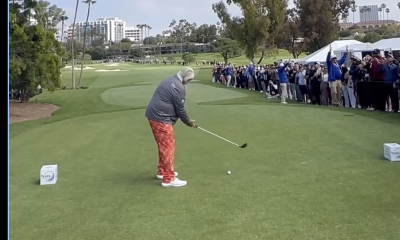
 19th Hole3 days ago
19th Hole3 days agoJohn Daly stuns fans into silence with brutal opening tee shot on PGA Tour Champions
-

 19th Hole7 days ago
19th Hole7 days ago2-time major champ announces shock retirement from the sport at age of 33
-

 19th Hole1 week ago
19th Hole1 week agoEdoardo Molinari reveals the latest PGA Tour golfer to turn down ‘good offer’ from LIV Golf
-
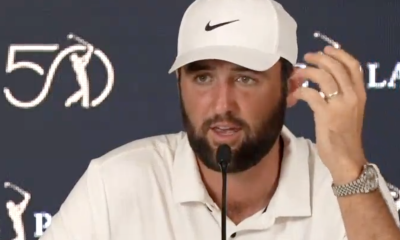
 19th Hole1 week ago
19th Hole1 week agoScottie Scheffler had an interesting response when asked how he ‘quiets the noise’ following Players victory
-
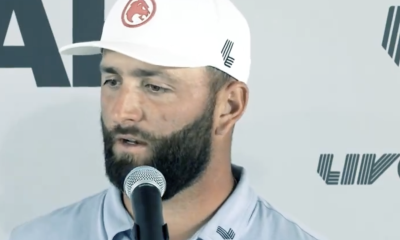
 19th Hole1 week ago
19th Hole1 week agoJon Rahm dealt fresh blow to hopes of qualifying for 2025 Ryder Cup
-

 Equipment2 weeks ago
Equipment2 weeks agoBest driver 2024: The best driver for you, as recommend by expert club fitters
-

 19th Hole3 days ago
19th Hole3 days agoCharlie Woods finds it tough going on American Junior Golf Association debut
-
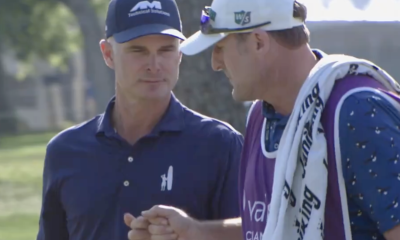
 19th Hole6 days ago
19th Hole6 days agoWhy Kevin Streelman sought USGA approval to use this equipment tool as he leads Valspar after round one





















Bill Vaile
Aug 23, 2019 at 9:08 am
I had the pleasure of meeting Payne Stewart at his home course, Hickory Hills in Springfield, Mo. I was one of the contestants in the long drive contest and was not familiar with the course. I was unloading my clubs from my car but had no idea how to get to the clubhouse when he pulled up next to me in a cart to load his. I asked him for directions and he said hop in and you can ride with me. He asked if I was playing that day and I explained that I was there for the long drive contest and had intended to play but as it looked like it might rain my playing partner was not going to show. Believe it or not I just thought he was a local member and did not know who it was at this time as it was early in his career although he had won a few tournaments. That and obviously was not expecting to run into him there. I believe he had recently won the Quad Cities Open. He said he was going to the practice range to warm up after doing some stretching on the floor of the clubhouse and asked if I wanted to go warm up so I did. Long story short when he started warming up I never hit another shot as it was amazing to watch him smooth through some four irons and some wedges. I thought I was pretty good at the time but proof that if you think you are good go watch a good pro and it will bring you back to earth. Basically got to spend the the day with and around him, got to meet his dad Bill and remember it like it was yesterday. He was a practical joker, always had something up his sleeve and was a very nice and gracious man.
How did I finally find out it was Payne Stewart? I hit a ball out of a fairway bunker from around 180 yds to within 5 ft. My cart partner said good shot and I said yes but not like that guy. He is a machine! I asked him if he was the club champion or ???? After the guy looked at me incredulously and after he had stopped laughing he said you don’t know who that is? that is Payne Stewart! All I knew up to then was that he was a very nice young man who was full of life and … pranks. Had a great day and a lifetime memory.
I will never forget the day my brother called me knowing my brief history with him and told me to turn on the news as there was a pro golfer on a plane that was not responding and it was thought that it was Payne Stewart onboard. Another lifetime memory but a very sad one. Only had that one day with him but it was one day more than many have and I will never forget it.
Howard Hayden
Aug 22, 2019 at 9:48 pm
Can’t wait to read your book. Saw Payne play Memphis a few times. Still watch videos of his swing hoping a sliver of his beautiful swing and rhythmic tempo will rub off. What a great loss.
joro
Aug 22, 2019 at 9:16 am
Back in the 70s when Payne was playing on the Golden State Tour I made Woods at Cobra and made all Paynes Woods. He would come into the shop and we would talk about his game and where he wanted to go. He also used Leather grips and I would change them a couple of times a year. He was a good guy and really appreciated everything. Then one day he was gone to the Tour and I only saw him one time after that, but he was a good friend and nice person.
I am glad he got his life in order when he got married, The game misses him, he was a true star.
Brian C
Aug 22, 2019 at 8:11 am
Great to see this story posted this morning. Unfortunately, I picked up golf after Payne’s passing and didn’t have the opportunity to experience his impact on the game in real-time, but having transformed into a bit of a golf history buff, I can’t wait to read this book when it hits the shelves.
Branden W
Aug 22, 2019 at 12:14 am
I learned the game of golf at 13. Payne Stewart was my favorite golfer. I grew up near Houston and was lucky enough to attend the Shell Houston Open a couple of times. In 1996, at the age of 19, I went to the SHO on a Thursday or Friday. I checked the tee times on the printed starter sheet and was able to follow Payne most of the day. On one particular hole, I actually got to interact with him. On the previous hole, he had made a putt, but only after the ball had swirled around once before falling in. I was standing right next to the tee box on the next hole. Being 19, I have no idea where I got the nerve, but I spoke up and said ‘Got kinda lucky on that last putt’. Payne, waiting to tee off, surprisingly responded to me. ‘Well, I got it out of the bottom of the cup. Doesn’t matter how it got there.’ I was shocked he had taken the time to respond. Later, after following him the rest of the round, I stood in line and got his autograph where he was signing as a rep for Top-Flite.
I got a few autographs while walking around later that day, but the experience with my favorite golfer of all-time will always be a memory I’ll never forget.
Tom Kelly
Aug 21, 2019 at 11:38 pm
In 1986 Greenwich Capital had a small golf outing at the Stanwich Club in Greenwich, CT. Payne Stewart was one of two professional golfer to play with a small number of people. At that time I was a competitive 2 handicap. After the conclusion of the round, about ten people are left having a beer or something and talking about golf. Payne Stewart jumps up and says “Let me show you!” So we walk out to a 150 yard marker on either the first or tenth tee and he starts hitting 8 irons. High 8 irons, low 8 irons, hooked 8 irons, sliced 8 irons, 135 yard 8 irons, 175 yard 8 irons… you get the drift. He was a truly classy person and a wonderful golfer.
Johnny Newbern
Aug 22, 2019 at 2:17 pm
Wow. What an experience. I’m jealous.
Think About It
Aug 21, 2019 at 9:38 pm
Nothing wrong with a guy having little/no filter. Most people specially now days need a person like that in their life. Sometimes the truth hurts but if a person actually wants to grow there is greatness on the other side of that hurt.
Payne was a great person and will always be missed. Great article and cant wait to read the book.
Tom54
Aug 21, 2019 at 5:21 pm
I was always hoping that the Tour Championship would reward the top 29 players a spot in their final event. Why 29? Because sadly that is the number they had when Payne died in that plane crash and did not attend. Having everyone wondering about 29 being the number I thought would have been a way to always keep him in their thoughts forever
12th
Aug 21, 2019 at 4:53 pm
I played with Tom Meeks years after he retired from the USGA. Of course everyone knows the story of Olympic and 98. Tom told me that Payne called him the next day and let him have it good for the hole location on 18. Over the course of 1999, Tom and him became good friends. The controversy turned into a great friendship. After Payne won in 99, Tom called him and asked two things. 1. Could he have the putter that Payne used. That was the first true SeeMore putter. Payne told him that he would send him one. 2. Tom asked to have the sleeves that Payne cut off of the pullover that he used in the final round. The first ever short sleeve pullover. Payne told him, “No way.” Payne dies in October and about a week or so later, Tom finally received that putter.
Joel Edwards and I are good buddies and he said that not a lot of people knew that Payne smoked, and smoked a lot early on. He used to steal cigarettes from Joel’s bag constantly. Joel would be warming up on the putting green, then turn around and see Payne diving in his bag for a few cigarettes.
Mike
Aug 21, 2019 at 4:17 pm
I played Mountain Top, Buffalo Ridge and Ozark National this weekend and we just kept staring down at the flat land where Payne’s Valley is taking shape. I think it’s going to be the best course of all of Bass Pro’s holdings and I think they planned for it to be that way.
Marc Miller
Aug 21, 2019 at 4:09 pm
I had heard that another book was coming out about Payne Stewart. I am so glad the man is not forgotten. I never had the pleasure of meeting him or interacting with him, but his life impacted mine in numerous ways. Thank you for this book. I look forward to reading it.
Johnny Newbern
Aug 21, 2019 at 4:40 pm
I think you are really going to enjoy it!
Tommy V
Aug 21, 2019 at 4:00 pm
I met Payne at a course in Springfield, MO on Thanksgiving Day 1998. He was going off the front 9 with 6 others including his son and his dad and at least 1 other junior player. We were making the turn and drove over to the tee to see him hit. It was very cold. Payne immediately stopped and told us to play through as we were a 2some. When I explained my reason for coming over, he went into this big production about how it was cold and he hadn’t hit any balls and went over the top with excuses in a funny way. He hit a pure smooth 3 wood right down the middle. Not wanting to intrude any more, we drove off right away. He yelled us down “Hey!! Well!!! How was that?” I laughed and said it was great. The 1st and 10th greens were next to each other and I went over and asked him to autograph my card. He was very gracious and wrote “Happy Thanksgiving, Payne Stewart” It’s a cherished momento of mine, one of the few autographs I’ve ever asked for.
Johnny Newbern
Aug 21, 2019 at 4:41 pm
What a great memory, Tommy. I am so glad you have that experience to keep forever.
Carroll Strange
Aug 21, 2019 at 3:15 pm
Johnny is also my grandson-in-law. He is a fine golfer, wonderful father and husband and all-around good guy!